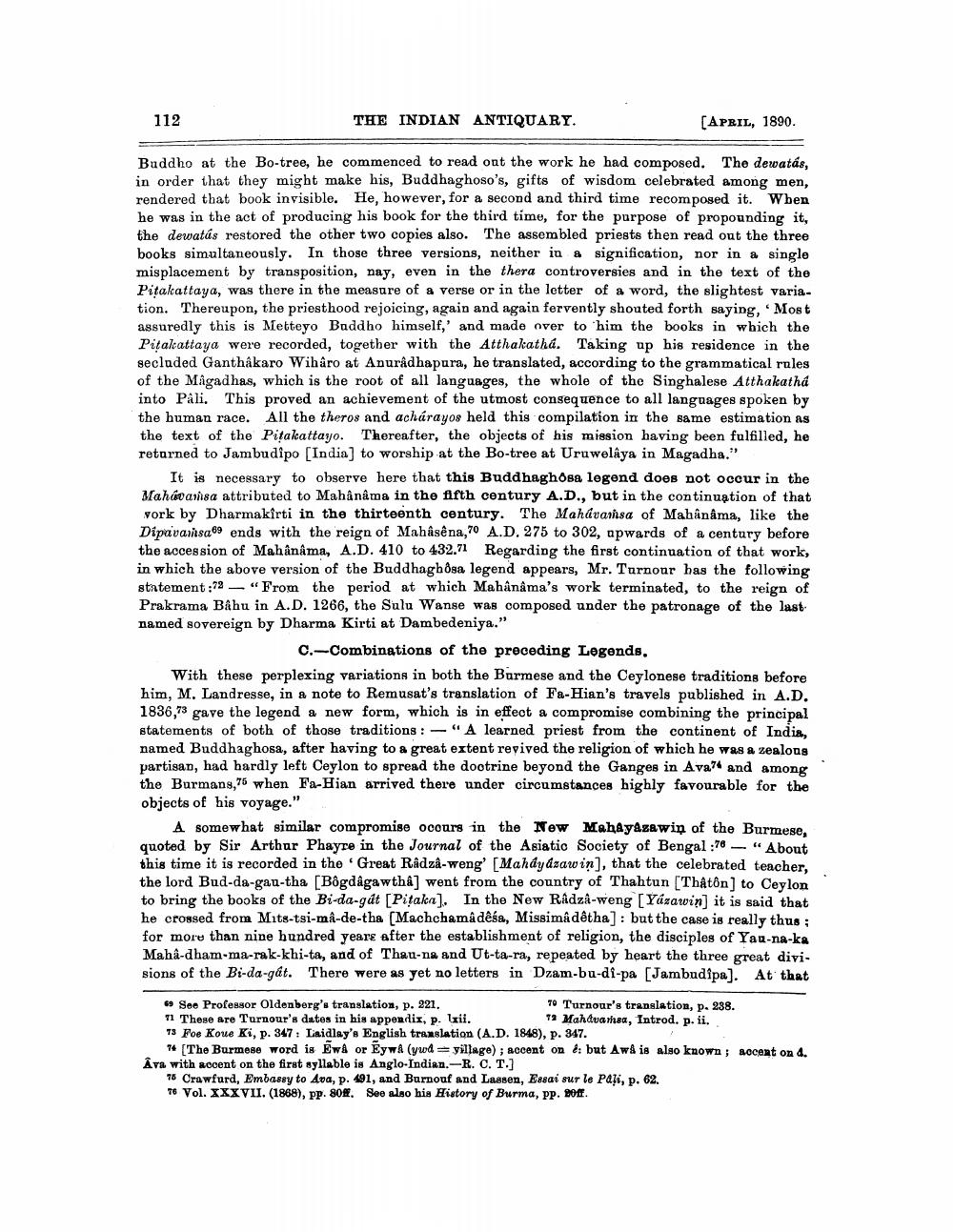________________
112
THE INDIAN ANTIQUARY.
[APRIL, 1890.
Buddho at the Bo-tree, he commenced to read out the work he had composed. The dewatás, in order that they might make his, Buddhaghoso's, gifts of wisdom celebrated among men, rendered that book invisible. He, however, for a second and third time recomposed it. Wben he was in the act of producing his book for the third time, for the purpose of propounding it, the dewatás restored the other two copies also. The assembled priests then read out the three books simultaneously. In those three versions, neither in a signification, nor in a single misplacement by transposition, nay, even in the thera controversies and in the text of the Pitakattaya, was there in the measure of a verse or in the letter of a word, the slightest variation. Thereupon, the priesthood rejoicing, again and again fervently shouted forth saying, Most assuredly this is Metteyo Baddho himself, and made over to him the books in wbich the Pitakattaya were recorded, together with the Atthakatha. Taking up his residence in the secluded Ganthakaro Wiharo at Anuradhapura, he translated, according to the grammatical rules of the Magadhas, which is the root of all languages, the whole of the Singhalese Atthakatha into Pâli. This proved an achievement of the utmost consequence to all languages spoken by the human race. All the theros and achárayos held this compilation in the same estimation as the text of the Pitakattayo. Thereafter, the objects of his mission having been fulfilled, he returned to Jambudipo (India) to worship at the Bo-tree at Uruwelâya in Magadha."
It is necessary to observe here that this Buddhaghosa legend does not occur in the Mahavarisa attributed to Mahânâma in the fifth century A.D., but in the continuation of that work by Dharmakirti in the thirteenth century. The Mahavarisa of Mahânâma, like the Dipavainsa69 ends with the reign of Mahasena, 70 A.D. 275 to 302, apwards of a century before the accession of Mahânâma, A.D. 410 to 432.71 Regarding the first continuation of that work, in which the above version of the Buddhaghðsa legend appears, Mr. Turnour has the following statement:72 — "From the period at which Mahânâma's work terminated, to the reign of Prakrama Bahu in A.D. 1266, the Sulu Wanse was composed under the patronage of the lastnamed sovereign by Dharma Kirti at Dambedeniya.”
C.-Combinations of the preceding Legends. With these perplexing variations in both the Burmese and the Ceylonese traditions before him, M. Landresse, in a note to Remusat's translation of Fa-Hian's travels published in A.D. 1836,73 gave the legend a new form, which is in effect a compromise combining the principal statements of both of those traditions : -"A learned priest from the continent of India, named Buddhaghosa, after having to a great extent revived the religion of which he was a zealong partisan, had hardly left Ceylon to spread the dootrine beyond the Ganges in Avam and among the Burmans,76 when Fa-Hian arrived there under circumstances highly favourable for the objects of his voyage."
A somewhat similar compromise ocours in the New Mahayazawin of the Burmese, quoted by Sir Arthur Phayre in the Journal of the Asiatic Society of Bengal :78 - "About this time it is recorded in the Great Radzâ-weng' [Mahdy drawin], that the celebrated teacher, the lord Bud-da-gau-tha [Bøgdagawthâ] went from the country of Thahtun [Thátôn] to Ceylon to bring the books of the Bi-da-gdt [Pitaka). In the New Radza-weng [Yazawin] it is said that he crossed from Mits-tsi-ma-de-tha (Machchamadeśa, Missimâ dêtha] : but the case is really thus ; for more than nine hundred years after the establishment of religion, the disciples of Yau-na-ka Mahà-dham-ma-rak-khi-ta, and of Thau-na and Ut-ta-ra, repeated by heart the three great divisions of the Bi-da-gåt. There were as yet no letters in Dzam-bu-di-pa [Jambudipa). At that
See Professor Oldenberg's translation, p. 221.
70 Turnour's translation, p. 238. 11 These are Turnour's dates in his appendix, p. lii.
12 Mahduarsa, Introd. p. ii. 73 Foe Koue Ki, p. 347 : Laidlay's English translation (A.D. 1848), p. 347.
14 The Burmese word is Ewa or EywA (ywdyillage); accent ond: but Awd is also known accent on 4. Ava with accent on the first syllable is Anglo-Indian.-R. C. T.]
76 Crawfurd, Embassy to Ava, p. 491, and Burnouf and Lassen, Essai sur le pagi, p. 62. 76 Vol. XXXVII. (1868), pp. 80. See also his History of Burma, pp. poff.




